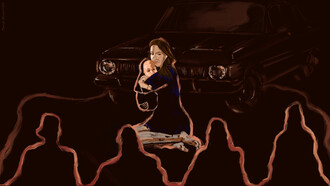Prof. Paul S. Cutter studied politics and comparative government at the universities of Iowa and California, graduated from ROTC – Reserve Officers Training Corps, as an officer and gentleman, lectured at the University of California, and served in the military, which concurrently led to the long-term deep-sink clandestine monitoring mission of the awesome Russian Armed Forces, especially the launch sites of the ICBM long-range ballistic missile systems, poised against the West. He is well known as a former American expert on Russia. In his writing career he specialized in the Russian Creative Intelligentsia and is the primary author of the profiled book, *Unofficial art in the Soviet Union, University of California Press (Berkeley), and Cambridge University Press (London), 1967; which identified the dissident movement in the Soviet Union as a continuation of the Great Experiment in Modern Art, that basically started in Russia at the turn of the 20th century… During the 1980’s Prof. Cutter became a member of JINSA (Jewish Institute for National Security of America) Board of Advisors. Prof. Cutter present areas of interest include globalization and conflicts & resolution.
I had the great pleasure of meeting Prof. Cutter in his family residence in the little town of Budva in Montenegro and talked about his new book related to Montenegrin identity, origin and history. It turns out that Prof. Cutter is an American, with his family roots originally from Montenegro. Even his part of the family lived longer than a century in the USA, Prof. Cutter surprises with fluent Montenegrin and traditional pronunciation in the glory of the old times.
Dear Prof. Cutter, as a native American you chose to settle in Montenegro. Why Montenegro has sparked your interest?
Because of my family background, settled in the Midwest (Iowa, later California), in the 1880s, shortly after the Berlin Peace Conference in 1878, and soon became homesteaders in Iowa.
You wrote numerous historical commentaries. Why did you become interested in Jewish history?
As a student of political science, including my graduate work – all of it was directed towards Marxism and communist studies, specializing in Russia/the Soviet Union, especially military strategy, and tactics.
I was an owner of a publishing house of a monthly trade magazine, in fact of military science & technology. Israel was in constant conflict with PLO, making news all the time. Moreover, the Pentagon, the US Secretariat of Defense had been for many years assisting the Jews in their persistent struggle with the neighboring Arabs, de facto, historically. Our publishing house wrote about in the magazines titled: military electronics/countermeasures, military science & technology, and defense systems review, i.e. three magazines, in which we frequently wrote about the Jewish ability to effectively use high-tech systems to defend its borders.
Being interested in military science, it’s also from my father, who was in a way on his own a military historian, an original gentleman farmer in Central Iowa, who was also an American hero of the Battle of Verdun (1916). In other words, he made sure I took ROTC in college or university, also to become an officer, instead of serving as a simple soldier; i.e. he would often say, we as a family were always officers.
Montenegro is a tiny country with a long and turbulent history. So much history produce this little country that even its neighbors are keen on the appropriation of its history and culture. Is there any connection between Jewish people and Montenegrin land in the past?
After the Alhambra Edict of March 31, 1492, singed by Queen Izabella of Seville and King Ferdinand of Aragon, 300,000 Jews were slated for expulsion from Spain, despite the fact that at least a dozen major cities of Span were built by immigrant Jews; 200,000 were converted to Catholicism, 100,000 were expelled: 60,000 moved to adjacent Portugal, the balance settled in Morocco and Tunisia (the so-called Maghreb), 10,000 moved to Montenegro, between 1497-1505, agreement reached with government of Ivan Crnojevich (d. 1490), and another 20,000 moved over the ensuing decades and centuries, for a total of 30,000 Jews, who quickly assimilated, losing the Jewish language and culture, i.e. by choice becoming Montenegrins, with mostly Montenegrin Slavicized last names. Today, there are only 500 souls, mostly in Podgorica, the capital.
In your new book about Jewish emigration you follow Jewish refugee routes across Europe, Africa and the Middle East. Why Montenegro is important to the Jewish community?
The territory was relatively large under the Balshich family rule, but demography was very limited, with large tracts of fertile land in the interior valleys and along the Adriatic Coast available for settlement. Demography at the time, endemic and migrant Slavs included, was limited to about 30,000. The overriding cultural and religious aspect was free to choose, though hard to believe? I think assimilation was more or less enforced, but you would know that better than I do… Such answers I still seek in sources and archives to verify before releasing the two volumes to the publishers.
Who is the most prominent Montenegrin of Jewish origin?
Petrovichi were assimilated; Njegosh had several advisors, who were from the 30 or so Jewish families which settled in Montenegro.
Are there any written facts about such a claim?
I haven’t found such sources, because such data was not kept. However, the Kotor and Dubrovnik archives have some documents, which I will quote. I have spent a great deal of my time on the first historical volume on Jewish history from 4,000 – 1492, before the arrival to Montenegro!
Research of yours is a very new approach to Montenegrin origin. Is there any other researcher paper about the Jewish origin of Montenegrin?
The literature is very limited, but for the Kotor Missal, which was popularized recently about the Jewish women.
To the Jewish community little town of Ulcinj in Montenegro is a place of importance. Why is that?
Sabbatai Cevi, the Jewish mystic, who was a consultant to Sultan Mehmet IV (1626-1676), arrived in Ulcinj with 29 families from Istanbul. He was 10 years in Ulcinj, living at the Balshich villa; no male progeny from two wives. We have found his remains, and I have secured one photo of his remains. The Mani family in Ulcinj are in charge of the remains, and, of course very protective!
What are future plans of the Jewish community for the town of Ulcinj?
There is a plan announced about building a museum to Sabatai Tsevi, plus a life-size monument! But, there’s a problem there, where one privateer, by the name “Gani”, without the approval of a life-size monument, which I have seen and photographed. But absconding without the approval of the Jewish community, just to promote his restaurant, has met with opposition. I’m not sure how all that will turn out, nor do I want to get involved; my interest is only the manuscript, the two volumes I’m hard at work to finish in the next few months, etc.
Could Montenegro establish special relations with the state of Israel due to the fact of mutual common origin?
I’m sure Israel is ready for such a relationship.















